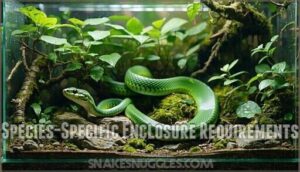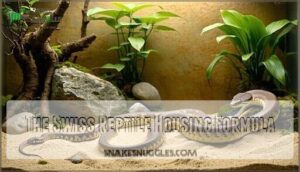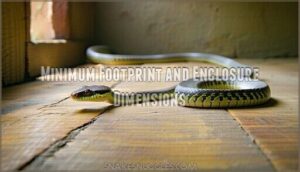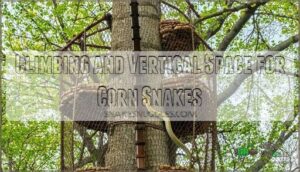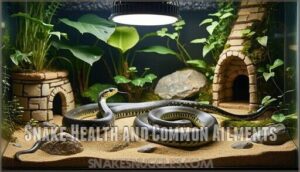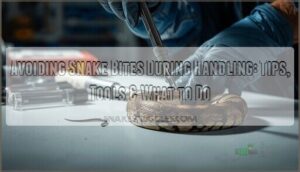This site is supported by our readers. We may earn a commission, at no cost to you, if you purchase through links.
 Choosing the right cage size for a snake isn’t rocket science, but it’s essential for your pet’s health.
Choosing the right cage size for a snake isn’t rocket science, but it’s essential for your pet’s health.
Your snake’s enclosure should be roughly two-thirds its body length—think of it as giving them room to stretch without feeling lost in a mansion.
Juvenile snakes need at least 10-20 gallons, while adults require larger spaces.
The longest side must match your snake’s length minimum.
Don’t forget temperature gradients with warm and cool zones, plus proper humidity levels for your specific species.
Getting the basics right prevents stress and promotes natural behaviors that keep your scaly friend thriving in ways most owners never realize.
Table Of Contents
- Key Takeaways
- Minimum Enclosure Size Matters
- Species-Specific Enclosure Requirements
- Avoiding Misinformation and Breeder Standards
- Room Conversions and Construction Assistance
- Corn Snake Terrarium Size Requirements
- Building and Maintaining a Healthy Environment
- Frequently Asked Questions (FAQs)
- How big of a tank is needed for a snake?
- Is a 40 gallon tank big enough for a corn snake?
- How big of a tank should a 3 foot snake have?
- What size cage does a python need?
- Is a 20-gallon tank big enough for a corn snake?
- What size tank does a 5ft snake need?
- What snakes can live in a 4x2x2?
- Whats the best way to measure my snakes length?
- Can I keep two snakes in the same enclosure?
- Is it true that snakes cant live in glass enclosures?
- Conclusion
Key Takeaways
- Your snake’s enclosure should be at least as long as your snake’s body length—a 4-foot snake needs a minimum 4-foot long tank to stretch comfortably
- Adult snakes typically require 4x2x2 feet minimum, but larger species like giant constrictors need room-sized enclosures or converted spaces
- Don’t trust breeders who recommend cramped cages—they’re prioritizing profit over your snake’s welfare, so verify sizing through veterinary sources and herpetological societies
- Proper cage size prevents stress-related health issues, supports natural behaviors like thermoregulation and exploration, and creates the foundation for a thriving pet
Minimum Enclosure Size Matters
Choosing the right cage size for your snake isn’t just about meeting minimum requirements—it’s about creating a space where your pet can thrive both physically and mentally.
An undersized enclosure can lead to stress, behavioral problems, and health issues that’ll make both you and your snake miserable.
Growth and Stress
Young snakes experience rapid Snake Development, quickly outgrowing their first enclosures.
Inadequate snake enclosure size creates Stress Factors that impact Growth Rates and overall health.
When your snake can’t fully stretch or move naturally, chronic stress develops, leading to serious Health Consequences like reduced appetite and weakened immunity.
A cramped cage creates a stressed snake – and stressed snakes get sick fast.
The Environmental Impact of cramped quarters affects both physical and behavioral development.
Proper snake space requirements mean your enclosure dimensions should accommodate your snake’s adult size from the start.
Natural Behavior and Husbandry
When your snake can’t express its natural behaviors, stress becomes inevitable.
Proper snake enclosure size and thoughtful habitat design create space for essential activities that keep your pet healthy and content.
- Thermoregulation – Moving between warm and cool zones for temperature control
- Exploration – Investigating their environment through scent and movement patterns
- Stretching – Fully extending their body length without restriction
- Hiding – Accessing secure retreats that provide psychological comfort and security
Ethical Considerations for Reptile Owners
Ethical ownership means putting reptile welfare first. You’re not just keeping a pet—you’re responsible for a living creature’s wellbeing.
Choose ethical breeders who prioritize animal ethics over profit margins. Your snake deserves proper space for natural behaviors.
| Ethical Factor | Poor Practice | Best Practice |
|---|---|---|
| Snake enclosure size | Minimum requirements only | Generous space for movement |
| Responsible breeding | Overcrowded breeding facilities | Spacious, clean conditions |
| Pet advocacy | Ignoring long-term needs | Planning for growth |
| Snake wellbeing | Basic survival setup | Enriched environment |
| Snake ethical considerations | Profit-focused decisions | Animal-centered choices |
Remember: bigger enclosures equal happier snakes.
Species-Specific Enclosure Requirements
Each snake species has unique space requirements that go beyond simple length calculations.
You’ll need to match your enclosure dimensions to your snake’s natural behaviors, size, and environmental needs for ideal health.
Ball Python Minimum Enclosure Size
Three key factors determine your ball python’s happiness: adequate snake cage size, proper environmental controls, and species-specific design. Adult ball pythons need minimum 4x2x2 feet enclosures, though 6x2x3 provides better comfort. The enclosure depth should accommodate your snake’s full snake length for natural stretching behaviors.
Happy snakes need room to stretch—bigger enclosures mean healthier, less stressed pets.
Here’s what creates the perfect ball python habitat:
- Floor space exceeding 8 square feet – prevents muscle atrophy and stress-related health issues
- Controlled humidity levels between 50-60% – maintains proper shedding and respiratory health
- Dual hide system with temperature control – offers security while supporting natural thermoregulation
Your snake terrarium size directly impacts ventilation needs and temperature gradients essential for long-term wellness. Proper enclosure size guidelines are essential for creating a healthy environment for your ball python.
Bearded Dragon Enclosure Size Needs
Moving from ball pythons to their lizard counterparts, bearded dragons need substantially more space due to their active nature.
Your bearded dragon tank requires minimum enclosure size of 4x2x2 feet, though 6x3x3 or 8x4x4 dimensions work better for temperature gradients and humidity control.
The extra enclosure depth supports natural behaviors like basking and exploring. Proper ventilation needs prevent moisture buildup, while adequate height accommodates lighting options that mimic their natural habitat.
This reptile tank size helps your dragon stay healthy and stress-free. To create an ideal environment, understanding reptile enclosure maintenance is vital for the well-being of your pet.
Leopard Gecko and Corn Snake Minimum Enclosure Sizes
When choosing the right home for your scaly friend, size matters more than you might think.
Both leopard geckos and corn snakes need specific dimensions to thrive in captivity.
Here’s what you need to know about minimum requirements:
- Leopard geckos require at least 36" x 18" x 18" for adults
- Corn snakes need minimum 48" x 24" x 24" dimensions
- Both species benefit from larger enclosures when possible
Your snake enclosure size should match your pet’s length—corn snake enclosures work best when they’re as long as your snake.
Proper habitat design and species research guarantee your reptile care meets their natural needs.
For ideal care, consider the terrarium size guidelines to create a suitable environment.
Large Reptiles Like Giant Snakes and Monitors
When dealing with massive reptiles like reticulated pythons and large monitors, you’re looking at Custom Habitats that go beyond traditional tanks.
These giants need Reptile Rooms or dedicated spaces—think room conversions rather than cages.
Monitor Housing often requires 12×8 foot minimum dimensions, while Giant Snake Care demands enclosures exceeding 8 feet in length.
Professional builders can help create these Large Enclosures with proper ventilation and security features.
Avoiding Misinformation and Breeder Standards
When researching snake enclosure sizes, you’ll encounter conflicting information from breeders who prioritize profit over animal welfare.
Always verify cage size recommendations through multiple reputable sources like herpetological societies, veterinarians, and established reptile care forums rather than relying solely on breeder advice.
Researching Reputable Sources
Finding reliable information about snake enclosure size can feel like traversing a maze of conflicting advice. You’ll encounter everything from outdated "rules of thumb" to scientifically-backed research that contradicts traditional practices.
Start with peer-reviewed studies – they’re your gold standard for accurate enclosure size guide information. Twenty-five publications support enclosures matching your snake’s full body length, while zero studies validate smaller recommendations.
Here’s where to find trustworthy snake cage recommendations:
- Reptile Forums with verified expert contributors and evidence-based discussions
- Herpetologist Guidance from university research departments and published studies
- Veterinary Recommendations from reptile specialists with hands-on experience
- Expert Advice from certified herpetological societies and professional organizations
- Online Reviews of enclosure manufacturers that reference scientific standards
Skip sources from the 1970s that lack empirical validation. Instead, look for reptile cage size information backed by behavioral studies showing snakes need full-body stretching space. Your snake’s welfare depends on getting accurate snake enclosure dimensions, not following outdated commercial breeding standards.
Choosing Ethical Breeders and Prioritizing Pet Needs
The best breeders put animal welfare first, not profit margins.
Ethical breeding practices mean providing spacious enclosures that meet snake housing requirements, even if it costs more.
Red flags include cramped breeding racks or dismissing proper snake enclosure size guidelines.
Responsible ownership starts with choosing breeders who demonstrate genuine reptile rights advocacy through their housing standards and snake care tips.
Educating Yourself on Responsible Reptile Ownership
Knowledge matters when choosing snake enclosure size recommendations. Your reptile research directly impacts snake welfare and supports responsible breeding practices.
- Verify cage size requirements through herpetological societies and veterinary sources rather than commercial breeders
- Choose ethical suppliers who prioritize snake enclosure size over profit margins and breeding efficiency
- Join reptile communities for owner education on proper reptile enclosure size standards and pet advocacy
- Document your findings to help other owners make informed decisions about snake cage size requirements
Understanding reptile handling safety is vital for preventing accidents and ensuring the well-being of snakes in captivity.
Room Conversions and Construction Assistance
When you’re keeping massive constrictors or large monitors, your regular terrarium won’t cut it—you’ll need to convert an entire room or hire professionals to build custom enclosures.
These giants require dedicated spaces with reinforced structures, proper ventilation systems, and specialized heating that can handle their impressive size and strength.
Housing Giant Snakes and Large Monitors
When you’re keeping giant snakes or large monitors, standard enclosures won’t work.
These massive reptiles need Snake Rooms or Giant Enclosures that span entire rooms.
Monitor Housing requires at least 2x length ratios, while Custom Builds for giant constrictors often mean converting spare bedrooms into Large Habitats with proper ventilation and security features.
Proper Giant Snake Enclosures design is essential for the health and well-being of the reptiles, and understanding snake enclosure systems can help in creating ideal environments.
Building a Suitable Enclosure With Professional Help
When you’re dealing with giant snakes or large monitors, professional builders become your best allies. Professional builders can offer room conversion services, especially for those housing massive reptiles that require dedicated spaces.
Here’s what experts bring to your Enclosure Design project:
- Custom Builds suited to your snake enclosure dimensions and specific species needs
- Professional Assistance with complex ventilation, heating, and security systems
- Reptile Experts who understand snake cage setup requirements and safety protocols
- Habitat Creation services that transform rooms into naturalistic environments
These specialists handle everything from structural modifications to reptile enclosure customization, ensuring your massive serpent gets the perfect home without you breaking a sweat. They also consider the importance of creating a bioactive ecosystem to promote a healthy environment for your pet snake.
Corn Snake Terrarium Size Requirements
Corn snakes need proper space to thrive, and getting their enclosure size right makes all the difference for their health and happiness.
You’ll want to understand the specific dimensions that work best for these active climbers before setting up their new home.
The Swiss Reptile Housing Formula
Swiss reptile housing standards provide a straightforward formula for snake enclosure size calculations. The Reptile Housing formula requires minimum floor area of (0.7 x snake length) × (0.5 x snake length).
This Space Calculations method guarantees proper Animal Welfare by letting your corn snake stretch fully. For a 4-foot corn snake, you’ll need 2.8 × 2 feet minimum footprint—that’s 5.6 square feet of floor space for healthy Habitat Design.
Proper temperature gradient controls are also essential for creating a suitable environment for your corn snake.
Minimum Footprint and Enclosure Dimensions
The enclosure dimensions for your corn snake should match its body length in both directions.
Your snake needs space requirements that allow full stretching – if you’ve got a 4-foot snake, plan for at least 4 feet of snake tank dimensions.
Enclosure depth matters too; aim for 2 feet minimum width.
This cage size prevents cramping and stress while supporting natural movement patterns.
Climbing and Vertical Space for Corn Snakes
Corn snakes love to climb, so vertical space matters just as much as floor area. You’ll want tall tanks that let your snake stretch upward and explore different levels naturally.
Here’s what your climbing setup needs:
- Snake ladders or sturdy branches positioned diagonally for easy access
- Climbing structures like cork bark or artificial vines secured properly
- Arboreal enclosures with at least 24 inches of height for adult snakes
- Multiple perching spots at different levels to create exploration zones
- Climbing branches thick enough to support your snake’s weight without bending
This vertical space setup mimics their natural habitat where corn snakes climb trees and bushes. Arboreal snakes need this dimension to stay physically fit and mentally stimulated.
Building and Maintaining a Healthy Environment
Once you’ve built the perfect-sized enclosure, you’ll need to create the right environment inside to keep your snake healthy and thriving.
The setup involves more than just throwing in some substrate and calling it done – temperature gradients, humidity levels, and proper enrichment all work together to mimic your snake’s natural habitat, including proper enrichment.
Reptile Cage Building and Customization
Building your own reptile enclosure lets you create the perfect home for your snake while saving money. You’ll have complete control over every detail, from snake enclosure size to custom designs that match your pet’s specific needs.
Start with safe enclosure materials like melamine or PVC panels. Avoid toxic woods like cedar that can harm your snake’s respiratory system. Plan your reptile cage dimensions carefully – remember that bigger is usually better for your snake’s wellbeing.
Here’s what you’ll need to account for:
- Ventilation systems with proper airflow to prevent stagnant air and maintain humidity
- Heating options like radiant heat panels or ceramic heat emitters for temperature gradients
- Bioactive setups with live plants and natural substrates for enrichment
- Secure locking mechanisms to prevent escapes – snakes are natural Houdinis
- Multiple access points for easy cleaning and snake handling
Custom cage designs allow you to incorporate climbing branches for corn snakes or deeper substrate areas for burrowing species. Your enclosure size guide should prioritize your snake’s natural behaviors over convenience. When designing a reptile enclosure, evaluate the reptile cage options available to guarantee the best environment for your pet.
Snake Care and Maintenance Essentials
Creating the right environment for your snake doesn’t stop once you’ve built the perfect enclosure. Daily care keeps your reptile healthy and content. Think of it like maintaining a tiny ecosystem where every detail matters for your snake’s wellbeing.
Your snake care routine should include these key elements:
- Snake Feeding schedules based on age and species – adults eat every 7-10 days, juveniles more frequently
- Reptile Lighting that mimics natural day-night cycles with 12-hour photoperiods
- Enclosure Security with proper locks and escape-proof latches on all access points
- Humidity Control maintained at species-appropriate levels using water bowls and substrate choices
- Ventilation Systems ensuring proper airflow without creating drafts that stress your snake
- Temperature gradients with basking spots and cooler retreats for thermoregulation
- Substrate maintenance using safe materials like aspen shavings or cypress mulch, avoiding cedar or pine
Regular spot-cleaning and monthly deep-cleaning keep your snake enclosure size optimized for health. Monitor your snake’s behavior – a well-maintained cage size promotes natural activities like exploring and proper digestion. Proper snake enclosure design is essential for maintaining a healthy environment. Remember, consistent care prevents most health issues before they start.
Snake Health and Common Ailments
While proper enclosure setup forms your snake’s foundation, monitoring their health prevents serious problems down the road. Snake health issues often stem from poor environmental conditions, making vigilant observation key to early detection.
Snake diseases like respiratory infections show symptoms including wheezing, mouth breathing, and nasal discharge. Snake parasites such as mites cause excessive scratching and visible crawling specks. Snake injuries from improper heating or sharp objects require immediate veterinary care.
You’ll need parasite control products for mites and regular fecal exams for internal parasites. Reptile nutrition affects immune function – underfed snakes develop more snake ailments.
Quarantine new animals for two weeks minimum. Remember, snake enclosure size directly impacts stress levels, which influences disease susceptibility.
Frequently Asked Questions (FAQs)
How big of a tank is needed for a snake?
Your snake’s tank needs to stretch their entire body length—imagine cramming yourself into a shoebox.
Most adult snakes require 4x2x2 feet minimum, but larger species need room-sized enclosures for comfort.
Is a 40 gallon tank big enough for a corn snake?
A 40-gallon tank works for adult corn snakes, though it’s the bare minimum. You’ll want at least 36 inches length since corn snakes need room to stretch and explore comfortably.
How big of a tank should a 3 foot snake have?
While smaller tanks feel cozy, they’re actually cramped prisons for your 3-foot snake.
You’ll need at least a 3-foot long enclosure, but a 4-foot tank gives them proper room to stretch and move naturally.
What size cage does a python need?
Adult pythons need enclosures at least 4x2x2 feet, but larger species like ball pythons thrive in 6x2x3 feet for ideal comfort and natural movement.
Is a 20-gallon tank big enough for a corn snake?
No, a 20-gallon tank isn’t adequate for adult corn snakes. While juveniles might temporarily fit, adults need at least 40 gallons minimum—think 4x2x2 feet for proper stretching and movement.
What size tank does a 5ft snake need?
Picture your 5-foot snake stretching from wall to wall—you’ll need a minimum 5-foot long enclosure.
Most experts recommend at least a 6-foot tank to give your snake room to fully extend and move comfortably.
What snakes can live in a 4x2x2?
You can house ball pythons, corn snakes, bearded dragons, blue tongue skinks, and king snakes in a 4x2x2 enclosure.
Ball pythons actually prefer these cozy dimensions, while corn snakes get adequate room to stretch and explore.
Whats the best way to measure my snakes length?
Gently stretch your snake along a measuring tape while it’s calm and relaxed.
You can also use a flexible cloth tape measure, following the snake’s natural curves from nose to tail tip for accurate measurement.
Can I keep two snakes in the same enclosure?
Generally, you shouldn’t house two snakes together. Compatible species need ample space, but most snakes stress easily, compete for resources, and risk disease transmission when cohabitated together.
Is it true that snakes cant live in glass enclosures?
That’s false. Glass enclosures work perfectly fine for snakes when properly set up with adequate ventilation, secure lids, and appropriate heating systems. Many keepers successfully use glass terrariums.
Conclusion
Proper cage size for a snake represents the foundation of responsible reptile stewardship—your serpent’s sanctuary shouldn’t resemble a cramped studio apartment.
You’ve learned that species-specific dimensions, environmental gradients, and behavioral enrichment work together seamlessly.
Remember, upgrading your snake’s living quarters isn’t just about meeting minimum requirements; it’s about creating a thriving ecosystem.
When you prioritize adequate space and proper setup, you’re investing in your pet’s long-term health and natural behaviors.
- https://www.thesprucepets.com/leopard-geckos-1236911
- https://www.cornsnakes.com/forums/threads/20-30-or-40-gallon-for-adult-corn-snake.114265/
- https://www.reptileforums.co.uk/threads/how-often-should-do-you-handle-your-snake.840289/
- http://www.esbconsult.com/esbcalc/esbunitconv.htm%20
- https://www.thebiodude.com/blogs/gecko-caresheets/leopard-gecko-caresheet-2024-updated

